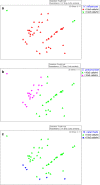Dominance of Haemophilus influenzae in ear discharge from Indigenous Australian children with acute otitis media with tympanic membrane perforation
- PMID: 24099576
- PMCID: PMC3852835
- DOI: 10.1186/1472-6815-13-12
Dominance of Haemophilus influenzae in ear discharge from Indigenous Australian children with acute otitis media with tympanic membrane perforation
Abstract
Background: Indigenous Australian children living in remote communities experience high rates of acute otitis media with tympanic membrane perforation (AOMwiP). Otitis media in this population is associated with dense nasopharyngeal colonization of three primary otopathogens; Haemophilus influenzae, Streptococcus pneumoniae and Moraxella catarrhalis. Little is known about the relative abundance of these pathogens during infection. The objective of this study was to estimate the abundance and concordance of otopathogens in ear discharge and paired nasopharyngeal swabs from children with AOMwiP (discharge of not more than 6 weeks' duration and perforation size <2%).
Methods: Culture and quantitative PCR (qPCR) estimation of H. influenzae, S. pneumoniae, M. catarrhalis and total bacterial load were performed on paired nasopharyngeal and ear discharge swabs from 55 Indigenous children with AOMwiP aged 3.5 - 45.6 months and resident in remote communities.
Results: By culture, H. influenzae, S. pneumoniae, and M. catarrhalis were detected in 80%, 84% and 91% of nasopharyngeal swabs, and 49%, 33% and 4% of ear discharge swabs, respectively. Using qPCR, H. influenzae, S. pneumoniae, and M. catarrhalis were detected in 82%, 82%, and 93% of nasopharyngeal swabs, and 89%, 41% and 18% of ear discharge swabs, respectively. Relative abundance of H. influenzae in ear discharge swabs was 0-68% of the total bacterial load (median 2.8%); whereas S. pneumoniae and M. catarrhalis relative abundances were consistently <2% of the total bacterial load. S. pneumoniae and M. catarrhalis abundances were significantly lower in ear discharge compared with nasopharyngeal swabs (p = 0.001, p < 0.001); no significant difference was observed in H. influenzae mean abundance at the two sites.
Conclusions: H. influenzae was the dominant otopathogen detected in ear discharge swabs collected from children with AOMwiP. High prevalence and abundance of S. pneumoniae and M. catarrhalis in the nasopharynx did not predict ear discharge prevalence and abundances of these pathogens. PCR was substantially more sensitive than culture for ear discharge, and a necessary adjunct to standard microbiology. Quantitative methods are required to understand species abundance in polymicrobial infections and may be needed to measure accurately the microbiological impact of interventions and to provide a better understanding of clinical failure in these children.
Figures





References
-
- Morris PS, Gadil G, McCallum GB, Wilson CA, Smith-Vaughan HC, Torzillo P. et al.Single-dose azithromycin versus seven days of amoxycillin in the treatment of acute otitis media in Aboriginal children (AATAAC): a double blind, randomised controlled trial. Med J Aust. 2010;192:24–29. - PubMed
-
- Morris PS, Ballinger D, Leach AJ, Koops H, Hayhurst B, Stubbs E, Recommendations for clinical care guidelines on the management of otitis media in Aboriginal and Torres Strait Islander populations. Indigenous EarInfoNet. 2001. http://www.healthinfonet.ecu.edu.au/other-health-conditions/ear.
-
- Leach A, Wood Y, Gadil E, Stubbs E, Morris P. Topical ciprofloxin versus topical framycetin-gramicidin-dexamethasone in Australian aboriginal children with recently treated chronic suppurative otitis media: a randomized controlled trial. Pediatr Infect Dis J. 2008;27:692–698. doi: 10.1097/INF.0b013e31816fca9d. - DOI - PubMed
-
- Murphy TF, Bakaletz LO, Smeesters PR. Microbial interactions in the respiratory tract. Pediatr Infect Dis J. 2009;28:S121–S126. - PubMed
LinkOut - more resources
Full Text Sources
Other Literature Sources

